Canine Cognitive Dysfunction (CCD): Symptoms, Causes and Treatments
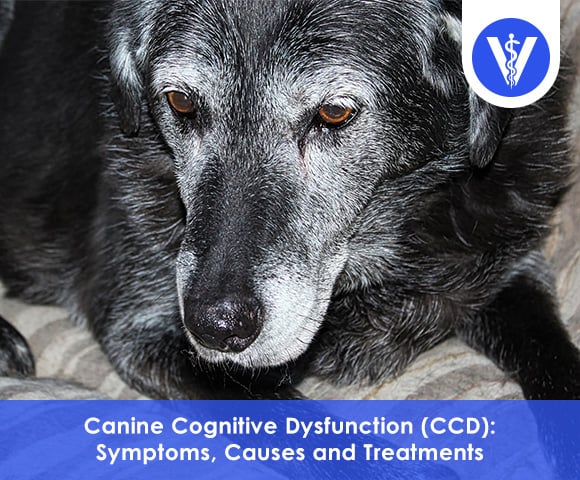
Table of Contents
Canine cognitive dysfunction (CCD) is an irreversible, progressive, neurodegenerative disease affecting one in three dogs over 11 years old. CCD targets the dog’s brain, causes cognitive impairment, and is the equivalent of Alzheimer’s Disease in humans.
The cause of cognitive dysfunction in dogs is not fully understood. Dogs with CCD show signs of brain atrophy and other changes in the brain, such as amyloid-β plaques and NFT-related TAU aggregates.
The early symptoms of canine cognitive dysfunction correspond with the aging process. Advanced stages of CCD in dogs manifest with disorientation, confusion, loss of coordination, anxiety, house soiling, changes in sleep patterns, and behavioral issues.
Canine cognitive dysfunction is used interchangeably with canine dysfunctional behavior. Canine dysfunctional behavior is an entirely different behavior that refers to an Autism-like condition in dogs, while cognitive dysfunction is the canine equivalent of dementia or Alzheimer’s disease in humans.
There is no cure for canine cognitive disorder, but it is possible to manage canine cognitive dysfunction using a multimodal approach, including medications, supplements, therapeutic diets, environmental modification, and cognitive enrichment.
Preventing or delaying the onset of CCD is easier than managing dogs with existing cognitive impairments. Dogs with CCD must have a healthy lifestyle, daily exercise, a quality diet, mental stimulation, and behavioral enrichment.
What is Canine Cognitive Dysfunction (CCD)?
Canine cognitive dysfunction (CCD) in dogs is an age-related dementia or a progressive, neurodegenerative disease manifesting with cognitive decline and deficits.
PetMD defines canine cognitive dysfunction or syndrome as “a condition related to the aging of a dog’s brain, which ultimately leads to changes in awareness, deficits in learning and memory, and decreased responsiveness to stimuli.”
Pet Health Network explains that “cognitive dysfunction is sometimes described as a “foggy brain”—a state in which normal, everyday functions are no longer simple.”
Canine cognitive dysfunction in dogs is very similar to Alzheimer’s Disease or dementia in people in terms of pathophysiology and clinical manifestation.
Canine cognitive dysfunction is widespread in senior dogs. Statistics show that one in three dogs older than 11 years has CCD. Dogs over 16 show at least one sign of cognitive impairment.
The dog breed does not predispose CCD in dogs. CCD in dogs affects spayed female dogs more than unneutered male dogs. Dogs with epilepsy and sedentary lifestyles are at higher-than-average risk of developing cognitive dysfunction.
How does CCD Work?
CCD in dogs works in three progressing stages: stage one (mild), stage two (moderate), and stage three (severe).
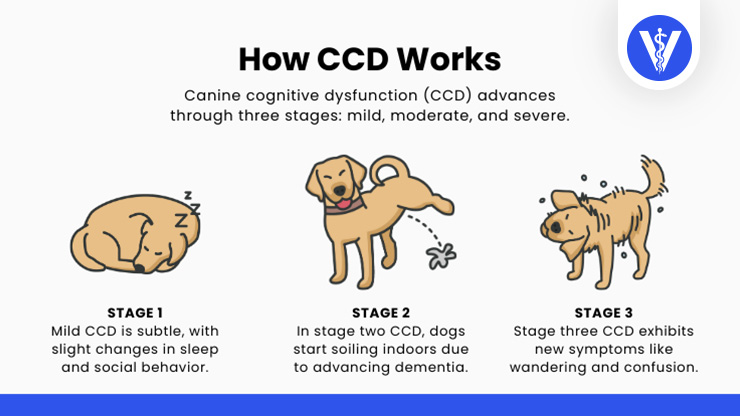
Stage one CCD is mild, manageable, and often unnoticed because the signs are hard to spot. The first stage of CCD manifests with slight changes in the dog’s sleeping patterns and social interactions with the owner and other pets.
Dogs in the second stage of CCD soil in the house. The dog’s dementia advances, and regardless of house training, it starts to urinate and defecate inside.
Behavior changes in stages one and two of CCD intensify in stage three. New symptoms emerge, such as wandering around the house, confusion, disorientation in familiar environments, anxiety, increased irritability, and unprovoked vocalization are all seen.
What are the Causes of CCD?
The causes of CCD are listed below.
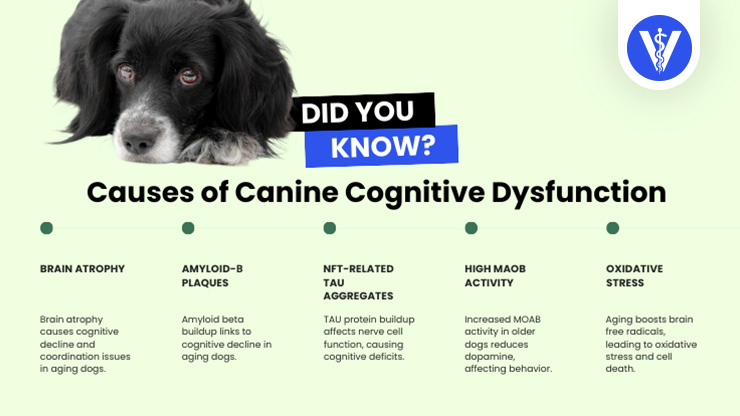
- Brain Atrophy: Atrophy is the medical term for wasting away or diminution. Brain atrophy, or loss of neurons and their connections, occurs as the dog ages and is one of the main causes of cognitive decline in senior dogs.
Head E., in the 2011 article “Neurobiology of the Aging Dog,” explained the presence of “neuron loss and reduced neurogenesis in the hippocampus of aged dogs.” The dog’s hippocampus is responsible for learning and memory, proving the link between brain atrophy and cognitive dysfunction.
Brain atrophy is pronounced in the cerebellar cortex, a portion of the brain responsible for coordination and balance. The loss of functional tissue in the cerebellum explains the tremors and falling or swaying tendencies in dogs with CCD.
- Amyloid-β Plaques: Accumulation of amyloid beta proteins in the extracellular (outside the cells) brain tissue and within the walls of the brain’s blood vessels (a condition known as cerebral amyloid angiopathy or CAA) is closely associated with cognitive impairment.
The reason amyloid-β accumulates is not fully understood. Scientists believe that plaques form due to small clots and microscopic bleeds that compromise the normal blood flow within the brain. Amyloid-β is theorized to have a toxic effect on nerve cells (neurons).
The Journal of Alzheimers disease published a paper, “Young to middle-aged dogs with high amyloid-beta levels in cerebrospinal fluid are impaired on learning in standard cognition tests,” in 2017. The study showed that young and middle-aged dogs with impaired learning skills have high levels of Aβ in the cerebrospinal fluid.
- NFT-Related TAU Aggregates: Neurofibrillary tangles (NFTs) are insoluble and twisted fibers made from protein TAU and are responsible for transporting nutrients within the nerve cell. TAU aggregates form when abnormally phosphorylated protein TAU builds up in the neurofibrillary tangles.
Nelson P. T. and Saper C. B., in the 1995 paper “Ultrastructure of neurofibrillary tangles in the cerebral cortex of sheep,” demonstrated that excess accumulation of highly phosphorylated microtubule-associated protein (TAU) in the NFTs causes cognitive and behavioral changes.
The working concept is that if hyperphosphorylated TAU is present in large intracellular (inside the cells) complexes or in high concentrations, hyperphosphorylated TAU has a toxic effect on the neurons and impairs normal neural functions. The reduced function causes cognitive deficits like CCD.
- High MAOB Activity: Older dogs have a higher activity of the monoamine oxidase B (MOAB) molecule, which breaks down dopamine. Dopamine is a neurotransmitter responsible for functions like mood, attention, and reaction. The more MOAB in the dog’s brain, the less dopamine, hence changes in behavior.
The Journal of Veterinary Medical Science published a study, “Molecular cloning of canine monoamine oxidase subtypes A (MAOA) and B (MAOB) cDNAs and their expression in the brain,” in 2003.
The authors acknowledged the link between MAOB and CCD but stated, “further study is needed to develop our understanding of canine MAO function and its postulated roles in the progress of canine cognitive function.”
- Oxidative Stress: Aging is associated with an increased level of free radicals in the brain. Free radicals are damaging molecules causing oxidative stress, which culminates in brain cell death.
Rafina J. E. and associate researchers in the 2006 paper “Cognitive disturbances in old dogs suffering from the canine counterpart of Alzheimer’s disease” say that “oxidative damage on a cellular and a nuclear level plays an important role in behavior changes.”
How Does CCD Affect Dogs?
Canine cognitive dysfunction, or CCD, affects dogs by altering their behavior, memory, sleep patterns, appetite, mental acuity, and activity. Dogs with CCD experience vision impairment, smell disturbance, tremors, swaying or falling, and head ptosis or tilting of the head.
A 2012 study, “Cognitive dysfunction syndrome: a disease of canine and feline brain aging,” states that CCD does not affect all dogs at the same level, but “once cognitive decline begins, it is generally a progressive disorder.”
Canine cognitive dysfunction (CCD) affects dogs the same way Alzheimer’s Disease affects people. Frontiers in Neuroscience published a paper, “Canine Cognitive Dysfunction and Alzheimer’s Disease – Two Facets of the Same Disease?” in 2019, comparing the two issues in detail. The study concluded that CCD and AD are similar in pathophysiology, clinical manifestation, and potential treatment options.
What are the Symptoms of Canine Cognitive Dysfunction?
The symptoms of canine cognitive dysfunction are listed below.
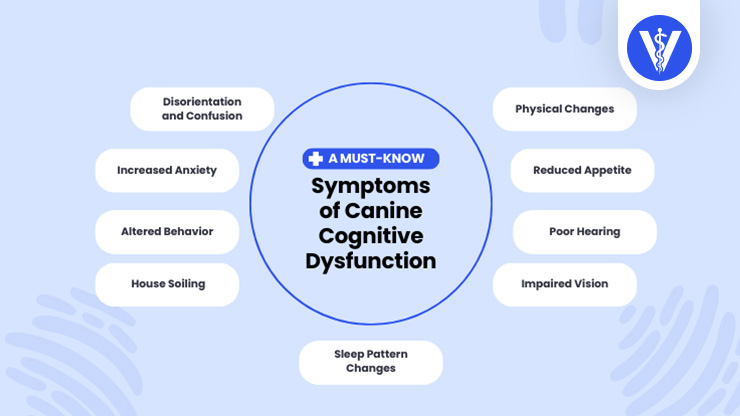
- Disorientation and Confusion: Disorientation and confusion in familiar environments are signs of early CCD. Typical manifestations include not recognizing family members and pets, pacing, staring blankly at the walls, and having difficulty moving around objects.
- Increased Anxiety: CCD makes dogs insecure, resulting in anxiousness. Anxiety signs in dogs with canine cognitive dysfunction are the inability to rest and relax, pacing, panting, excessive licking, vocalization, newly developed noise phobias, and separation stress.
- Altered Behavior: Canine cognitive dysfunction triggers changes in the dog’s behavior, including unprovoked irritability, reduced interaction with the owners, avoidance of other pets in the house, disinterest in daily activities, decreased grooming, and increased sleeping during the day.
- House Soiling: Dogs with CCD house soil (defecate and urinate inside the house) despite previous toilet training. Dogs forget how to use the doggy door or how to signal the need to go outside, and when outside, forget to go to the toilet.
- Sleep Pattern Changes: Canine cognitive dysfunction affects the sleep-wake cycle and makes dogs wakeful and roam at nighttime. Dogs are unable to settle down and sleep and are prone to excess vocalization, pacing around the house, or waking up and being anxious for no apparent reason.
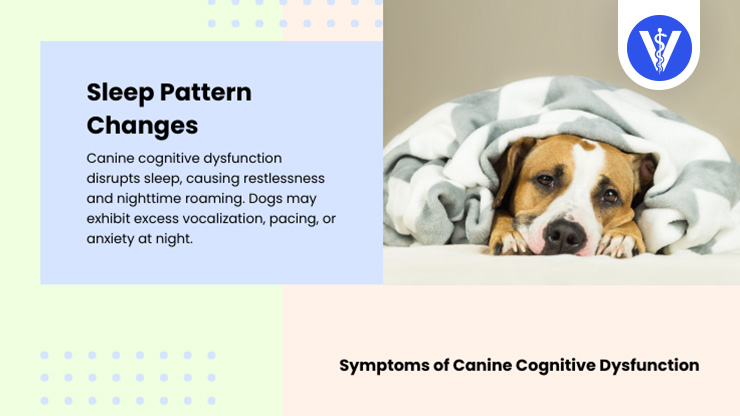
- Impaired Vision: Old age and CCD affect the dog’s senses, including vision. Poor vision manifests with reluctance to move, even in familiar surroundings, and frequent bumping into objects. Reduced sensitivity to light and enlarged pupils are common signs of vision decline in dogs.
- Poor Hearing: Dogs with CCD suffer hearing decline. Dogs with CCD do not react to loud noises and fail to comply with sound commands, making the dog appear disobedient.
- Reduced Appetite: Older dogs have slower metabolisms and are prone to dental issues and tooth loss, causing reduced appetite and food intake. Canine cognitive dysfunction worsens the problem by adding anxiety and diminishing the dog’s senses, which makes food less palatable.
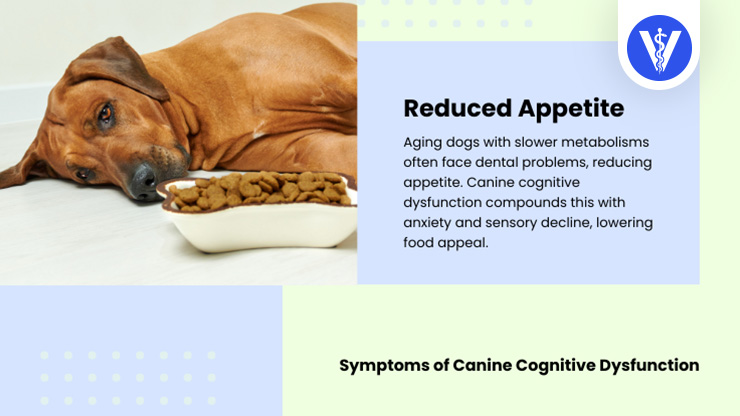
- Physical Changes: Gait and posture disorders are physical changes in dogs with canine cognitive dysfunction. A 2019 study, “Physical signs of canine cognitive dysfunction,” published in the Journal of Veterinary Medical Science, found that tremors, swaying or falling, and head ptosis are widespread in dogs with CCD.
What Age Does CCD Occur in Dogs?
Cognitive dysfunction in dogs occurs in dogs over eight years old. Every dog is different, and the onset of clinical signs varies among individuals, but the average time is eight years.
The Journal of Small Animal Practice published a study titled “Prevalence and risk factors of behavioral changes associated with age-related cognitive impairment in geriatric dogs” in 2009.
The study found that cognitive dysfunction occurs in dogs after age eight. The table below lists the ages CCD occurs in dogs.
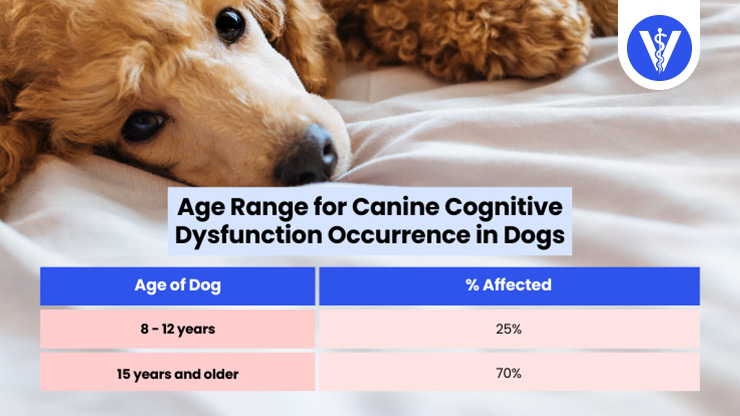
Can CCD be Treated?
No, CCD cannot be treated. A combination of management approaches improves the dog’s cognitive function and increases quality of life. Dr. Carrie Jurney, DVM, DACVIM (Neurology), states canine cognitive dysfunction, “treatment is aimed at slowing down the progression of the disease and minimizing symptoms.”
Cognitive enrichment activities like puzzles, toys, and new environments stimulate the brain and minimize anxiety in CCD dogs. Dog food made to boost brain function supports cognitive function in CCD dogs.
What is the Treatment for CCD?
The treatment for CCD is multimodal and includes medications, supplements, dietary changes, environmental modifications, and cognitive enrichment.
One FDA-approved medication for treating canine cognitive dysfunction in dogs is Selegiline or Anipryl®. Selegiline is an MAOB inhibitor, meaning it reduces the high MAOB activity in dogs with CCD and increases dopamine levels in the brain.
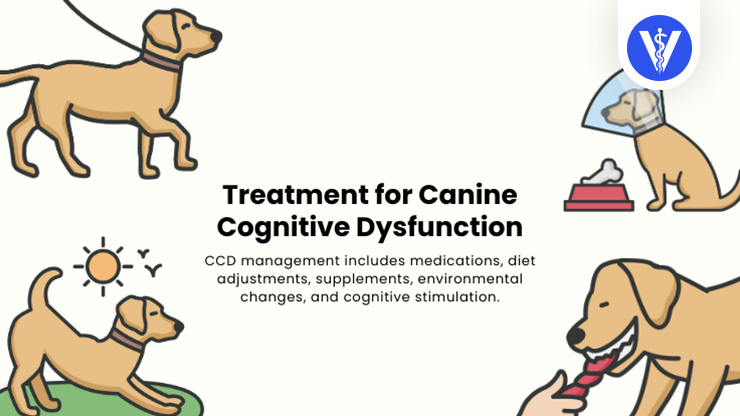
Veterinary Therapeutics, in 2001, published an animal trial, “A noncomparative open-label study evaluating the effect of selegiline hydrochloride in a clinical setting.” 641 dogs were given selegiline hydrochloride for two months.
The medication resulted in an enhancement in 77.2% of dogs. Activity and sleep-wake patterns improved in 67.8% of the dogs, and disorientation and interaction with family members improved in 77.8%. The drug was well-tolerated, with diarrhea, appetite loss, and vomiting or salivation being the most common side effects.
Popular supplements for CCD management include fish oil, melatonin, CBD products, Senilife®, S-adenosylmethionine (SAM-e), and medicinal mushrooms. Supplements alone do not achieve significant improvement but are helpful when combined with drugs and diet modifications.
Animals published a survey-based study, “Investigating Owner Use of Dietary Supplements in Dogs with Canine Cognitive Dysfunction,” in 2023. The survey was completed by 394 owners of dogs with canine cognitive dysfunction and concluded that 54% of dogs are managed with dietary supplements, with fish oil being the most commonly used product in 48% of the cases.
8% of the owners decided to change their dogs’ basic diets. Diet changes do not yield immediate results. Therapeutic food formulas quickly boost a dog’s brain health. Therapeutic food formulas require months to show visible effects.
Frontiers in Nutrition published an animal trial, “Efficacy of a Therapeutic Diet on Dogs With Signs of Cognitive Dysfunction Syndrome (CDS): A Prospective Double Blinded Placebo Controlled Clinical Study,” in 2018. Dogs fed a therapeutic diet with 6.5% MCT oil and a brain protection blend showed significantly improved cognitive function at the end of the trial.
Many pet food brands offer commercial dog food formulas for brain support and neurological health. Making a dietary change and switching the dog to a therapeutic diet is integral to canine cognitive disorder management.
Environmental modifications, like dietary changes, are important for controlling the dog’s surroundings and preventing exacerbation of the issue, while cognitive enrichment with new activities and stimulation helps keep the dog’s brain active, slowing down the progression of CCD.
What are Long Term Effects of CCD for Dogs?
The long-term effects of CCD for dogs are listed below.
- Anxiety: Canine cognitive dysfunction triggers anxiety, and as CCD advances, the anxiety worsens. Anxiety harms the dog’s physical and mental well-being and reduces longevity. A 2020 study published in Scientific Reports titled “Prevalence, comorbidity, and breed differences in canine anxiety in 13,700 Finnish pet dogs” said that “anxious dogs may be more vulnerable to diseases and show decreased lifespan.”
- Weight Loss: Reduced appetite is a side effect of canine cognitive dysfunction. A prolonged decrease in food intake results in weight loss, indirectly affecting the immune system’s potency. The immune system requires nutrients to stay, and the dog is more susceptible to pathogens when the immune responses are weakened.
- Lack of Sleep: The alterations in the sleep-wake cycle in dogs with CCD result in sleep deprivation. Veterinarska Stanica issued a paper in 2022 titled “How are you sleeping, my beloved dog? Healthy sleep of pet dogs as a factor of welfare: a review.” The authors explain that “sleep-deprived animals are more susceptible to health decline factors and sleep-deprived dogs experience stress, leading to increased susceptibility to health issues.”
- Poor Hygiene: Compromised hygiene is one of the long-term effects of CCD in dogs. Cognitive dysfunction affects bowel and bladder control, resulting in house soiling and accidents. Dogs with CCD are disinterested in grooming themselves, which adds to the problem and causes an unkempt appearance.
- Periodontal Disease: Open Veterinary Journal, in 2021, published a study, “Periodontal disease is associated with cognitive dysfunction in aging dogs: A blinded prospective comparison of visual periodontal and cognitive questionnaire scores.” The study found a “significant association between periodontal and cognitive scores.” Dogs with higher cognitive impairment scores had more severe periodontal disease and the other way around. The exact link was not determined.
How does CDB Oil Help CCD Treatment for Dogs?
CBD oil helps the CCD treatment for dogs through its neuroprotective effects and by helping manage the symptoms of canine cognitive dysfunction.
CBD has strong neuroprotective properties, as confirmed in a 2018 paper, “Review of the Neurological Benefits of Phytocannabinoids” by Maroon J. and Bost J.

Frontiers in Pharmacology published a study, “In vivo Evidence for Therapeutic Properties of Cannabidiol (CBD) for Alzheimer’s Disease,” in 2017, featuring a mouse model with Alzheimer’s Disease. The study concluded that “CBD can reverse cognitive deficits and neuronal death,” “reduce oxidative stress and neuroinflammation,” and “facilitate removal of Aβ plaques and reduce their production; and decrease tau protein aggregation.”
Considering the similarities between Alzheimer’s Disease and canine cognitive dysfunction, it is safe to assume the same effects are possible in dogs.
CBD oil helps the CCD treatment through symptom management, with an emphasis on anxiety. Stress relief is critical in dogs with CCD because anxiety is a major component of cognitive dysfunction.
CBD, or cannabidiol, is a natural compound extracted from the hemp version of the Cannabis sativa plant. CBD accounts for over 40% of hemp’s extract and is the most impactful member of the group of cannabinoids.
CBD oil is made by extracting the cannabinoids from the hemp plant and diluting them with a carrier oil, usually MCT coconut or hemp seed oil. Dog CBD oil works naturally through the endocannabinoid system (ECS) and is health-boosting, non-addictive, and non-psychogenic.
Is CBD Oil Safe for Animals?
Yes, CBD oil is safe for animals. Used responsibly, with a veterinarian’s approval, and in the recommended doses, hemp-sourced CBD oil is safe for dogs.
The answer is yes for pet owners asking, “Is CBD safe for animals?” CBD from hemp, made exclusively for pets, is non-addictive and non-psychogenic, and dogs do not overdose on high CBD oil doses.
Frontiers in Veterinary Science performed a study, “Pharmacokinetics, Safety, and Clinical Efficacy of Cannabidiol Treatment in Osteoarthritic Dogs,” in 2018. The results showed “no side effects” following CBD oil use in dogs.
The National Center for Biotechnology Information, in a paper titled “Preliminary Investigation of the Safety of Escalating Cannabinoid Doses in Healthy Dogs” from 2020, found that “dogs tolerated dose escalation of the CBD oil well.”
What are the Benefits of CBD for Dogs CCD?
The benefits of CBD for dogs with CCD are listed below.
- Natural Support: CBD boosts cognition and relieves anxiety by interacting with the dog’s endocannabinoid system (ECS). Natural pet products are safe to use long term and have fewer side effects than traditional medication. High-quality CBD products are made with organic ingredients and are free from potentially harmful additives. Dogs with CCD benefit from CBD supplementation.
- Wide Safety Margins: Sourced from the hemp version of the Cannabis sativa plant, CBD for dogs is a natural product with wide safety margins. Dogs are unable to overdose on hemp-derived CBD products, and cannabinoids are safe for all canines over the age of four months, regardless of body weight or size.
- Safe to Combine: Cannabinoids are natural substances and safe to combine with other mainstream drugs. Senior dogs with canine cognitive dysfunction suffer from co-existing conditions that require medications. Talk to the veterinarian to ensure CBD is safe with medications and supplements.
- No Significant Side Effects: CBD for dogs is not associated with long-term and serious side effects. Cannabinoids cause transient and benign adverse events in sensitive dogs. Establish the correct dosage, and the side effects stop. Dogs with CCD using CBD do not build tolerance after prolonged use.
- Available in Many Forms and Flavors: CBD products for dogs with CCD come in many forms and pet-friendly flavors. CBD offerings include oils, chews, and capsules in chicken, bacon, and peanut butter flavors. CBD oils work faster compared to CBD treats and other edibles.
- Prescription-Free: Pet CBD products for dogs with canine cognitive dysfunction are available over-the-counter (OTC) and do not require a veterinarian prescription. CBD oils and treats are easy to purchase online and in pet stores. Always consult the vet before starting dogs on CBD.
- Extra Health Benefits: The benefits of CBD to animals go beyond cognition support and anxiety relief. CBD for dogs boosts the immune system, promotes good sleep and appetite, and helps with common ailments such as allergies, seizures, arthritis, cancer, and glaucoma.
What are the Side Effects of CBD for Dogs while on CCD Treatment?
The side effects of CBD for dogs while on CCD treatment are listed below.
- Lethargy: Low energy, increased tendency to sleep, and disinterest in daily activities are common but benign side effects of CBD use in dogs.
- Dizziness: Loss of balance and coordination or ataxia are signs of dizziness, which occurs in dogs given low-quality CBD products high in Tetrahydrocannabinol THC. THC is the cannabinoid that makes humans “high” and is toxic to dogs. Give dogs with CCD CBD products sourced from hemp.
- Dry Mouth: Cannabinoids temporarily block saliva production, which results in a dry mouth or xerostomia, which is uncomfortable and increases the risk of dental issues, especially in older dogs with CCD and periodontal disease.
- Vomiting: Vomiting occurs in dogs with sensitive stomachs and is the result of the CBD or the carrier oil used to dilute the cannabinoids.
- Diarrhea: Diarrhea manifests with loose and frequent stool and is a frequent CBD side effect, especially in dogs not used to cannabinoid supplements.
- Upset Stomach: New supplements, including dog CBD products, have the potential to cause stomach upsets, clinically presenting with vomiting, diarrhea, and appetite loss.
- Liver Enzyme Changes: CBD affects the liver’s cytochrome P450 enzyme and alters how the dog metabolizes certain medications. Dogs with CCD need veterinary approval before taking CBD to ensure the CBD use does not interfere with the other CCD medications.
- Increased Tremors: Increased tremors are an extremely rare CBD side effect in dogs, unlike humans, who often experience such adverse events.
- Increased Itchiness: Dogs experience increased itchiness on rare occasions after starting to use CBD supplements
- Low Blood Pressure: Cannabinoids drop the dog’s blood pressure, causing hypotension, which is one of the common but transient side effects of CBD to animals.
How Much CBD Should be Administered to Dogs with CCD?
Dogs with CCD should be administered between one and five milligrams of CBD per 10 pounds of body weight. Split the daily dose into two servings to ensure the CBD effects last all day.

Always start with the lowest CBD dose suggested for the pet’s weight and health, then gradually increase the amount. A safe starting dose is around 2 mg per 10 pounds or 0.2 mg per pound of body weight.
Dogs are different and respond uniquely to cannabinoids, and CBD dosing guidelines are definitive. Dosage adjustments are common and normal, with some dogs with CCD responding to lower and others to higher CBD amounts.
Talk to a veterinarian, read the manufacturer’s instructions, or use a CBD dosage calculator to determine the ideal CBD amount for the dog’s body weight.
How can CCD be Prevented on your Dog?
CCD can be prevented or delayed by providing an antioxidant-rich diet and ensuring ongoing mental stimulation through training and interactive games.
Neurobiology of Aging conducted a clinical trial in 2005 titled “Learning ability in aged beagle dogs is preserved by behavioral enrichment and dietary fortification: a two-year longitudinal study.” The researchers discovered a slower age-dependent cognitive decline in dogs with behavioral enrichment combined with antioxidant-rich diets.
Mental stimulation keeps the dog’s brain sharp and maintains cognition. A 2017 study, “Utilising dog-computer interactions to provide mental stimulation in dogs, especially during ageing” presented at the Fourth International Conference on Animal-Computer Interaction, found that “continued mental stimulation helps slow aging in dogs.”
Basic obedience and advanced training is an excellent form of providing mental stimulation. Interactive playtime is beneficial and includes hide-and-seek games, puzzle toys and feeders, and dog sudoku.
How Long Can Dogs Live with CCD?
Dogs with CCD can live their full life expectancy. Cognitive dysfunction does not affect the dog’s longevity but harms the dog’s quality of life.
Dogs with severe and unmanaged dementia are euthanized around two years after the clinical signs of cognitive dysfunction appear due to poor quality of life.
The prognosis is better for promptly diagnosed and treated dogs. Errante P. published a study, “Canine Cognitive Dysfunction Syndrome: A Challenge in Treatment and Improvement in the Quality of Life of Older Dogs,” in 2022. The study concluded that “early diagnosis and treatment installation are fundamental to improving behavioral, clinical signs, quality and increased life expectancy of geriatric dogs” with canine cognitive dysfunction.
Fast R. and his associates, in the 2013 paper “An observational study with long-term follow-up of canine cognitive dysfunction: clinical characteristics, survival, and risk factors,” say that “dogs with CCD seem to have a good chance of living a full lifespan if supported by the veterinarian and the owner.”
Is CCD Common for Aging Dogs?
Yes, CCD is common for aging dogs. Statistics suggest that 60% of dogs over the age of 11 show signs of cognitive dysfunction, meaning nearly two-thirds of senior dogs older than 11 years of age suffer from some level of dementia.
Canine cognitive dysfunction is often underdiagnosed. Salvin H. and associates issued an observational study, “Under diagnosis of canine cognitive dysfunction: a cross-sectional survey of older companion dogs,” in 2010. The study showed that canine cognitive dysfunction occurred in 14.2% of the observed dogs, but “only 1.9% are diagnosed by veterinarians, with an exponential increase in prevalence with age.”
Is CCD a Sign of Anxiety for Dogs?
No, CCD is not a sign of anxiety for dogs. Anxiety is a sign of canine cognitive dysfunction and a critical component of the syndrome.
Anxiety is a common problem in modern dogs and is caused by a plethora of factors, including old age, separation, illness, and previous trauma. Age-related anxiety stems from cognitive dysfunction and the decline of the dog’s mental acuity and senses.
Dog anxiety greatly impacts the quality of life and harms the dog’s physical and mental well-being.
















